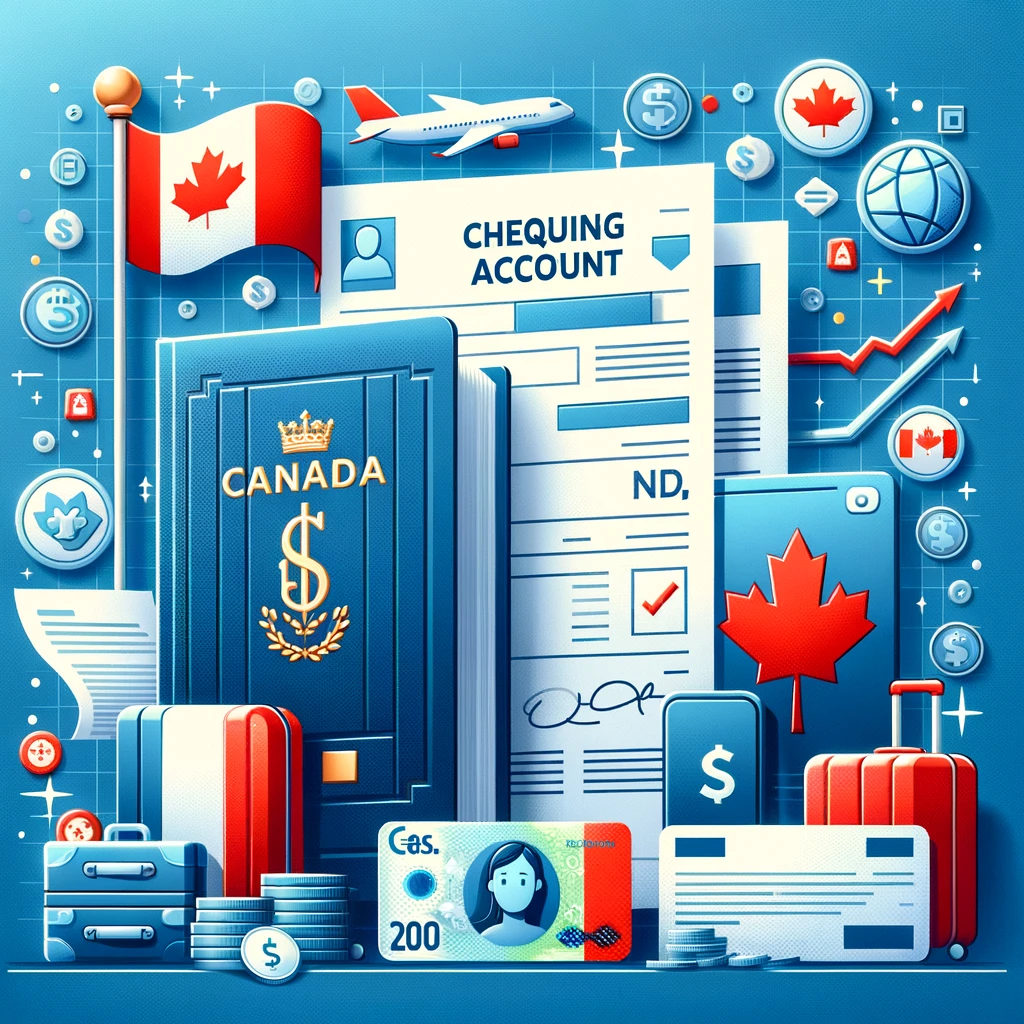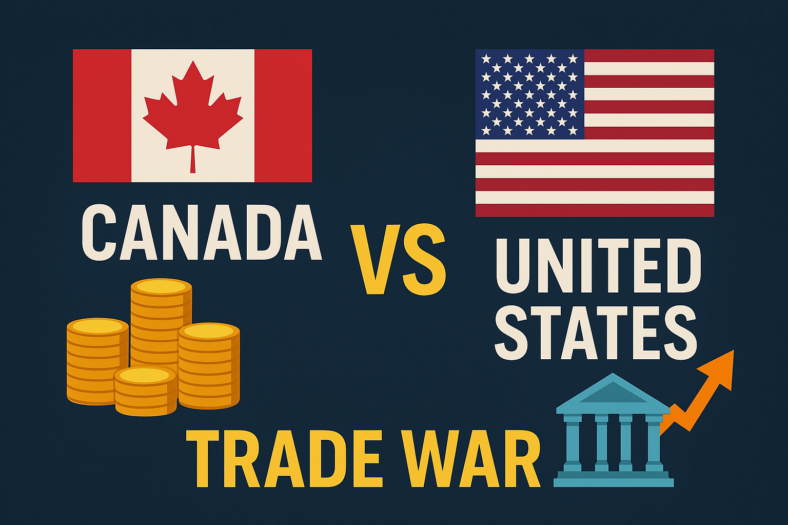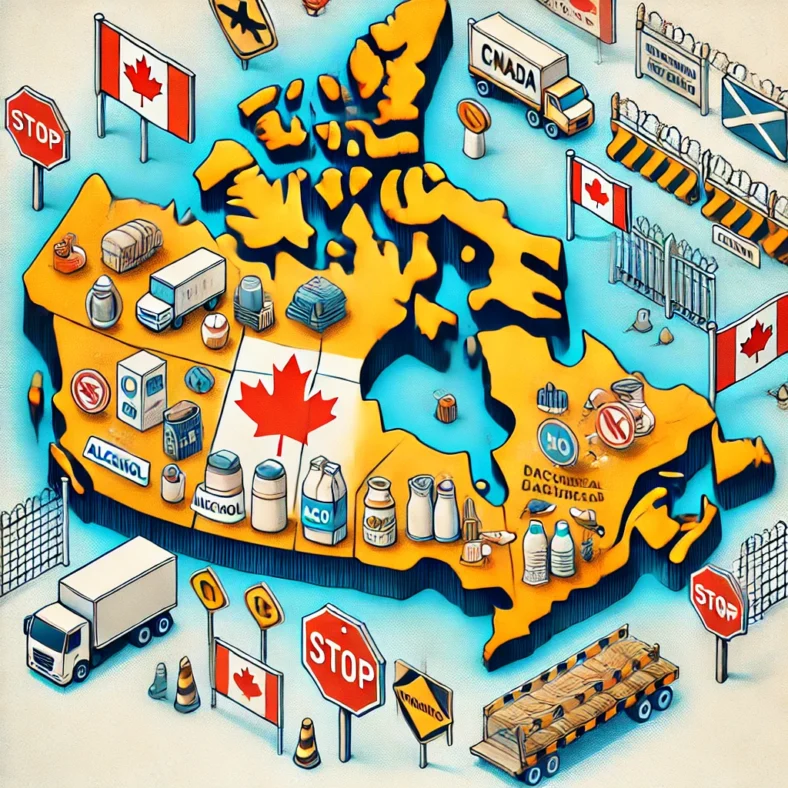For newcomers to Canada, navigating the financial landscape can be both exciting and daunting. One of the fundamental aspects of managing finances in Canada is understanding chequing accounts. A chequing account serves as a cornerstone for daily financial transactions, offering a safe and convenient way to manage your money. In this guide, we’ll delve into the intricacies of chequing accounts, covering everything from their purpose and benefits to how to choose the right one for your needs. Whether you’re new to Canada or simply looking to enhance your understanding of banking in this country, this guide aims to provide comprehensive insights into chequing accounts, empowering you to make informed financial decisions.
Editor’s Picks: Best Chequing Accounts for Newcomers to Canada
Types of bank accounts for newcomers to Canada
Newcomers to Canada have several types of bank accounts to consider, each tailored to different financial needs and preferences. The primary types of bank accounts include:
- Chequing Accounts: These accounts are designed for day-to-day transactions, such as depositing paychecks, withdrawing cash, and paying bills. Chequing accounts often come with features like debit cards, online banking, and direct deposit services.
- Savings Accounts: Savings accounts are ideal for setting aside money for future goals or emergencies. They typically offer higher interest rates compared to chequing accounts, helping your savings grow over time. Some savings accounts may have restrictions on withdrawals or minimum balance requirements.
- High-Interest Savings Accounts (HISAs): HISAs are similar to regular savings accounts but offer higher interest rates, making them attractive for maximizing savings. These accounts may have higher minimum balance requirements or limited transaction capabilities.
- Registered Retirement Savings Plans (RRSPs): RRSPs are tax-advantaged accounts designed to help Canadians save for retirement. Contributions to RRSPs are tax-deductible, and investments within the account grow tax-deferred until withdrawal, usually during retirement.
- Tax-Free Savings Accounts (TFSAs): TFSAs allow individuals to save and invest money tax-free. Contributions are not tax-deductible, but withdrawals, including any investment gains, are not subject to income tax. TFSAs are flexible accounts that can be used for various savings goals, such as buying a home or retirement.
- Youth Accounts: Many banks offer special accounts for children and teenagers, designed to teach financial literacy and encourage savings habits from a young age. These accounts may come with features like no monthly fees, parental controls, and educational resources.
- Student Accounts: Specifically tailored for students, these accounts often offer low or no monthly fees, overdraft protection, and other perks to accommodate the unique financial needs of students.
Understanding the differences between these accounts can help newcomers to Canada choose the right banking products to meet their financial goals and circumstances. It’s essential to compare features, fees, and benefits before opening an account to ensure it aligns with your needs.
What is a chequing account for newcomers to Canada?
A chequing account for newcomers to Canada serves as a foundational tool for managing day-to-day finances in the country. It’s essentially a transactional account provided by banks and credit unions, designed to handle regular financial activities like depositing paychecks, making purchases, paying bills, and withdrawing cash.
Here’s a detailed breakdown of what a chequing account entails for newcomers:
- Basic Features: Chequing accounts typically come with essential features such as a debit card for making purchases and accessing ATMs, online banking for managing transactions remotely, and the option for direct deposit of paychecks or government benefits.
- Transaction Flexibility: These accounts allow for various types of transactions, including deposits, withdrawals, electronic transfers, and cheque writing. This flexibility makes it convenient for newcomers to handle their day-to-day financial needs seamlessly.
- No or Low Monthly Fees: Many banks offer chequing accounts with no monthly fees for newcomers or with fees waived for a certain period. This can be advantageous for those who are just starting to establish their finances in Canada.
- Overdraft Protection: Some chequing accounts may offer overdraft protection, which allows you to overdraw your account up to a certain limit without incurring hefty fees. This feature can provide peace of mind, especially during times of financial uncertainty.
- Foreign Exchange Services: Since newcomers may have financial ties to their home country, some chequing accounts offer foreign exchange services for transferring money internationally or converting currencies. These services can be useful for managing finances across borders.
- Multilingual Support: Many banks in Canada offer customer support and banking services in multiple languages, which can be particularly helpful for newcomers who may not be fluent in English or French.
- Access to Financial Education: Some banks and credit unions provide resources and support to help newcomers understand the Canadian banking system, including workshops, informational materials, and online tools.
Overall, a chequing account for newcomers to Canada serves as a crucial tool for establishing financial stability and integrating into the Canadian banking system. By leveraging its features and benefits, newcomers can efficiently manage their day-to-day finances and navigate the complexities of banking in their new home country.
Common fees for chequing accounts for newcomers to Canada
Chequing accounts for newcomers to Canada may come with various fees, although some banks offer special packages with reduced fees or fee waivers for a limited time to attract newcomers. Here are some common fees associated with chequing accounts:
- Monthly Account Maintenance Fee: This fee is charged by many banks for the maintenance and administration of the chequing account. The amount can vary depending on the type of account and the bank’s fee structure.
- Transaction Fees: Some chequing accounts may charge fees for each transaction conducted, such as withdrawals, transfers, cheque writing, and bill payments. These fees can add up, especially if you perform a high volume of transactions each month.
- ATM Fees: If you use ATMs that are not affiliated with your bank’s network, you may incur ATM fees for withdrawals or balance inquiries. These fees can vary depending on the ATM provider and your bank’s policies.
- Overdraft Fees: If you overdraw your account by making a transaction that exceeds your available balance, you may be charged an overdraft fee. This fee can be substantial, so it’s essential to monitor your account balance closely to avoid overdrafts.
- Interac e-Transfer Fees: Some banks charge fees for sending or receiving Interac e-Transfers, which are electronic transfers of funds between individuals or businesses. These fees typically apply if you exceed a certain number of transactions per month or if you’re sending funds to a non-participating bank.
- Foreign Transaction Fees: If you make purchases in foreign currencies or withdraw cash from ATMs abroad, you may incur foreign transaction fees or currency conversion fees. These fees can vary depending on the bank and the type of transaction.
- Dormancy Fees: If you have a chequing account that remains inactive for an extended period, you may be charged a dormancy fee. This fee is intended to encourage account holders to keep their accounts active by making transactions regularly.
It’s essential for newcomers to Canada to review the fee schedule provided by their bank carefully and understand the conditions under which fees may be charged. Some banks offer fee waivers or discounts for newcomers, so it’s worth exploring these options to minimize the cost of banking services. Additionally, maintaining a clear understanding of your account activity and avoiding unnecessary fees can help you manage your finances more effectively.
Common features that chequing accounts for newcomers to Canada have
Chequing accounts for newcomers to Canada typically offer a range of features tailored to meet the day-to-day financial needs of individuals who are new to the country’s banking system. Here are some common features you can expect to find:
- Debit Card: Most chequing accounts come with a debit card that allows you to make purchases at retail stores, online merchants, and withdraw cash from ATMs. Debit cards are essential for accessing funds in your chequing account conveniently.
- Online Banking: Almost all banks provide online banking services, allowing you to manage your account, view transactions, pay bills, transfer funds, and set up alerts from your computer or mobile device. Online banking is a convenient way to monitor your finances and conduct transactions remotely.
- Mobile Banking App: Many banks offer mobile banking apps that complement their online banking services. These apps enable you to access your account on the go, deposit cheques remotely, transfer funds, and even pay bills using your smartphone or tablet.
- Direct Deposit: Chequing accounts often support direct deposit, allowing you to receive your salary, government benefits, pensions, or other payments directly into your account. Direct deposit is a convenient and secure way to access your funds without having to visit a bank branch.
- Bill Payments: Chequing accounts typically offer bill payment services, allowing you to pay your bills electronically through online banking or the mobile app. This feature eliminates the need for writing and mailing paper cheques, saving you time and hassle.
- Interac e-Transfers: Many chequing accounts include Interac e-Transfer functionality, enabling you to send money securely and quickly to friends, family, or businesses using only their email address or mobile phone number. This feature is particularly useful for splitting bills or sending money to loved ones.
- ATM Access: Chequing accounts provide access to a network of ATMs where you can withdraw cash, check your balance, or perform other transactions. Some banks offer fee-free access to a large network of ATMs, while others may charge fees for using ATMs outside their network.
- Customer Support: Banks typically offer customer support services to assist you with any questions or concerns you may have about your account. This support may be available through phone, email, online chat, or in-person at bank branches.
These common features make chequing accounts for newcomers to Canada versatile and convenient tools for managing day-to-day finances efficiently. When choosing a chequing account, consider which features are most important to you and how they align with your banking preferences and lifestyle.
Why should you choose a chequing account for newcomers to Canada?
Choosing a chequing account for newcomers to Canada offers several benefits that can help streamline financial management and integration into the Canadian banking system. Here are some compelling reasons to opt for a chequing account:
- Essential for Daily Transactions: A chequing account is essential for conducting day-to-day financial transactions, such as depositing paychecks, paying bills, making purchases, and withdrawing cash. Having a chequing account ensures you have a secure and convenient way to manage your money.
- Establishes Financial Identity: Opening a chequing account helps newcomers establish a financial identity in Canada. Having a local bank account is often required for various purposes, including renting accommodation, setting up utilities, and applying for credit cards or loans.
- Access to Banking Services: With a chequing account, you gain access to a wide range of banking services offered by Canadian financial institutions, such as online banking, mobile banking, direct deposit, bill payment, and Interac e-Transfers. These services make it easier to manage your finances efficiently and securely.
- Builds Credit History: Using a chequing account responsibly by maintaining a positive balance and making timely payments can contribute to building a positive credit history in Canada. This can be beneficial when applying for credit products like loans, mortgages, or credit cards in the future.
- Convenient for International Transactions: Many chequing accounts offer features like foreign exchange services and international wire transfers, making it convenient for newcomers to manage transactions with their home country or conduct international business.
- Supports Financial Integration: By opening a chequing account, newcomers can start integrating into the Canadian banking system and familiarize themselves with its practices, regulations, and services. This integration is essential for navigating the financial landscape and accessing resources tailored to newcomers’ needs.
- Access to Newcomer Packages: Some banks offer special banking packages or incentives designed specifically for newcomers to Canada. These packages may include fee waivers, preferential interest rates, and additional perks to help ease the transition and reduce financial stress.
Overall, choosing a chequing account for newcomers to Canada provides a solid foundation for managing finances effectively, building financial stability, and integrating into the local banking system. It’s essential to compare the features, fees, and benefits offered by different banks to find the chequing account that best suits your needs and preferences as a newcomer.
Benefits of chequing accounts for newcomers to Canada
Chequing accounts offer numerous benefits for newcomers to Canada, providing a crucial tool for managing finances and integrating into the country’s banking system. Here are some key benefits of chequing accounts for newcomers:
- Convenience: Chequing accounts provide a convenient way to manage day-to-day financial transactions, such as depositing paychecks, paying bills, and making purchases. With features like debit cards, online banking, and mobile banking apps, newcomers can access their funds and conduct transactions anytime, anywhere.
- Establishing Financial Identity: Opening a chequing account helps newcomers establish a financial identity in Canada, which is essential for accessing various financial services and participating in the economy. Having a local bank account demonstrates financial stability and responsibility, which can be beneficial for future endeavors such as renting accommodation, applying for credit, or seeking employment.
- Access to Banking Services: Chequing accounts provide access to a wide range of banking services offered by Canadian financial institutions, including direct deposit, bill payment, Interac e-Transfers, and more. These services make it easier for newcomers to manage their finances efficiently and securely, without the need for cash transactions.
- Building Credit History: Using a chequing account responsibly by maintaining a positive balance and making timely payments can contribute to building a positive credit history in Canada. This is important for newcomers who may eventually seek credit products such as loans, mortgages, or credit cards.
- Integration into the Banking System: Opening a chequing account allows newcomers to familiarize themselves with the Canadian banking system, its practices, regulations, and services. This integration is essential for navigating financial transactions, accessing resources, and making informed financial decisions in their new country.
- Support for International Transactions: Many chequing accounts offer features such as foreign exchange services and international wire transfers, making it convenient for newcomers to manage transactions with their home country or conduct international business.
- Special Banking Packages: Some banks offer special banking packages or incentives specifically tailored for newcomers to Canada. These packages may include fee waivers, preferential interest rates, and additional perks to help ease the transition and reduce financial stress.
Overall, chequing accounts play a vital role in facilitating financial stability, convenience, and integration for newcomers to Canada. By opening a chequing account, newcomers can take advantage of the benefits offered by the Canadian banking system and begin building a solid foundation for their financial future in their new home country.
Downsides of chequing accounts for newcomers to Canada
While chequing accounts offer numerous benefits for newcomers to Canada, there are also some potential downsides and challenges to consider:
- Monthly Fees: Many chequing accounts charge monthly maintenance fees, which can vary depending on the type of account and the bank. For newcomers who may be adjusting to new financial responsibilities, these fees can add up and create an additional financial burden.
- Transaction Fees: Some chequing accounts impose fees for certain transactions, such as ATM withdrawals, Interac e-Transfers, and overdrafts. These fees can increase the cost of banking services, especially if newcomers frequently use these transaction methods.
- Overdraft Fees: Overdrawing a chequing account can result in hefty overdraft fees, which are charged when the account balance becomes negative. For newcomers who may be unfamiliar with the banking system or managing their finances, accidental overdrafts can lead to unexpected fees and financial stress.
- Minimum Balance Requirements: Some chequing accounts require a minimum balance to be maintained to avoid monthly fees or qualify for certain benefits. For newcomers who may have fluctuating income or limited savings, meeting these minimum balance requirements can be challenging.
- Limited Access to Credit: Chequing accounts typically do not offer credit-building features such as credit cards or loans. While responsible use of a chequing account can contribute to building a positive credit history, newcomers may face challenges accessing credit products without a substantial credit history or established banking relationship.
- Foreign Exchange Fees: For newcomers who need to make international transactions or transfer funds to their home country, chequing accounts may incur foreign exchange fees or currency conversion fees. These fees can reduce the value of the transferred funds and increase the overall cost of financial transactions.
- Limited Banking Options: Depending on their location and banking preferences, newcomers may have limited options when choosing a chequing account. Some banks may have fewer branches or ATM networks in certain areas, which can impact accessibility and convenience.
- Language Barriers: For newcomers who are not proficient in English or French, navigating banking services and communicating with customer support staff may be challenging. While many banks offer multilingual services, language barriers can still pose obstacles to understanding account terms and procedures.
Overall, while chequing accounts provide essential banking services and opportunities for newcomers to Canada, it’s essential to consider the potential downsides and explore options carefully to find an account that aligns with their financial needs and circumstances.
How to choose a chequing account for newcomers to Canada
Choosing the right chequing account is an important step for newcomers to Canada to manage their finances effectively and integrate into the banking system. Here’s a comprehensive guide on how to choose a chequing account:
- Assess Your Needs: Begin by evaluating your financial needs and preferences. Consider factors such as your transaction frequency, ATM usage, need for international transactions, and desire for additional banking services like overdraft protection or online banking.
- Research Bank Options: Research different banks and credit unions in Canada to explore their chequing account offerings. Consider factors such as account features, fees, branch and ATM locations, customer service reputation, and special packages for newcomers.
- Compare Account Features: Review the features and benefits offered by each chequing account, such as debit card access, online banking, mobile banking apps, bill payment services, Interac e-Transfers, and foreign exchange capabilities. Look for accounts that align with your needs and provide the services you require.
- Consider Fees and Charges: Pay close attention to the fees associated with each chequing account, including monthly maintenance fees, transaction fees, ATM fees, overdraft fees, and foreign exchange fees. Choose an account with fee structures that are transparent and affordable based on your anticipated banking activity.
- Look for Newcomer Packages: Some banks offer special banking packages or incentives specifically designed for newcomers to Canada. These packages may include fee waivers, preferential interest rates, and additional perks to help ease the transition and reduce financial stress. Explore these options to maximize benefits as a newcomer.
- Review Minimum Balance Requirements: Check if the chequing account requires a minimum balance to be maintained to avoid monthly fees or qualify for certain benefits. Consider whether you can comfortably meet these requirements based on your financial situation and income stability.
- Examine Accessibility: Consider the accessibility of the bank’s branches and ATMs, especially if you prefer in-person banking or frequently use cash. Choose a bank with a convenient branch and ATM network that meets your needs, whether you’re located in a metropolitan area or a more remote region.
- Evaluate Customer Service: Assess the quality of customer service provided by the bank, including availability, responsiveness, and language support. Look for banks that offer multilingual services or resources to assist newcomers who may require assistance in languages other than English or French.
- Read Reviews and Testimonials: Read reviews and testimonials from other customers to gain insights into their experiences with the bank and its chequing accounts. Consider factors such as satisfaction with account features, customer service, and overall banking experience when making your decision.
- Open the Account: Once you’ve selected a chequing account that meets your needs and preferences, follow the bank’s procedures to open the account. Be prepared to provide identification documents and complete any necessary paperwork, either online or in-person at a branch.
By following these steps and carefully evaluating your options, you can choose a chequing account that serves as a reliable and convenient financial tool for your transition to Canada. Don’t hesitate to reach out to bank representatives or financial advisors for guidance and assistance in selecting the right account for your specific circumstances.
How to open a chequing account for newcomers to Canada
Opening a chequing account as a newcomer to Canada is a straightforward process, typically requiring a few key steps. Here’s a comprehensive guide on how to open a chequing account:
- Choose a Bank: Research different banks and credit unions in Canada to find one that offers chequing accounts suitable for newcomers. Consider factors such as account features, fees, branch and ATM locations, customer service reputation, and special packages for newcomers.
- Gather Required Documents: Before visiting the bank to open an account, gather the necessary identification and documentation. Commonly required documents include:
- Valid passport or government-issued photo identification
- Proof of address in Canada (e.g., utility bill, rental agreement)
- Social Insurance Number (SIN) or proof of application for SIN
- Employment or study permit (if applicable)
- Proof of income (e.g., employment letter, pay stubs)
- Visit the Bank Branch: Visit the nearest branch of the chosen bank with your identification and documentation. Schedule an appointment if necessary, although many banks also accept walk-in appointments for opening accounts.
- Meet with a Bank Representative: Upon arrival at the bank branch, inform the staff that you would like to open a chequing account as a newcomer to Canada. A bank representative will assist you in selecting the appropriate account and guide you through the account opening process.
- Complete Account Application: Fill out the required account application forms provided by the bank. Provide accurate personal information, contact details, and employment or study information as requested. Be prepared to answer questions about your banking needs and preferences.
- Provide Identification: Present your identification documents to the bank representative for verification. This may include your passport or government-issued ID, proof of address, and SIN or proof of SIN application.
- Deposit Initial Funds: Some banks may require an initial deposit to open a chequing account. Deposit the required funds into the account, either in cash or through a bank transfer from another account.
- Review and Sign Documents: Carefully review the terms and conditions of the chequing account, including any fees, features, and account agreements. Sign the necessary documents to finalize the account opening process.
- Receive Account Information: Once the account is opened successfully, the bank will provide you with account details, including your account number, debit card, and instructions for accessing online banking or mobile banking services.
- Activate and Manage the Account: Activate your debit card and set up online banking or mobile banking to start managing your chequing account. Familiarize yourself with account features, transaction limits, and security measures to ensure smooth banking experiences.
By following these steps and providing the required documentation, you can open a chequing account as a newcomer to Canada and gain access to essential banking services to manage your finances effectively. If you have any questions or need assistance during the account opening process, don’t hesitate to ask the bank representative for guidance.
Who’s eligible for a chequing account for newcomers to Canada?
Eligibility criteria for chequing accounts for newcomers to Canada can vary depending on the bank or credit union offering the account. However, in general, the following individuals are typically eligible to open a chequing account as newcomers:
- Permanent Residents: Individuals who have obtained permanent resident status in Canada are usually eligible to open a chequing account. Permanent residents hold the right to live, work, and study in Canada indefinitely and are entitled to most of the same benefits and services as Canadian citizens.
- Temporary Residents: Temporary residents in Canada, such as international students, foreign workers, and visitors on valid visas or permits, may also be eligible to open a chequing account. Banks may require proof of temporary residency status, such as a valid study permit, work permit, or visitor visa.
- Newcomers to Canada: Individuals who have recently arrived in Canada and are in the process of establishing themselves in the country are often eligible for chequing accounts designed specifically for newcomers. These accounts may offer special features, fee waivers, or incentives to facilitate the transition to Canadian banking.
- Newcomer Families: In addition to individual newcomers, newcomer families, including spouses and dependent children, may be eligible to open chequing accounts collectively. Banks may require documentation for each family member, such as passports, visas, or proof of family relationship.
- Minors: Minors who have immigrated to Canada with their families or who are studying in Canada as international students may also be eligible to open a chequing account. In such cases, a parent or legal guardian may need to co-sign the account and provide consent for banking activities.
- Refugees and Asylum Seekers: Refugees and asylum seekers who have been granted legal status in Canada are typically eligible to open chequing accounts. Banks may require documentation from immigration authorities confirming their refugee or asylum status.
It’s important to note that specific eligibility requirements and documentation may vary among banks and financial institutions. Some banks offer specialized chequing accounts or banking packages tailored specifically for newcomers to Canada, which may have additional eligibility criteria or documentation requirements.
Before opening a chequing account as a newcomer, it’s advisable to research different banks, review their account offerings, and inquire about their specific eligibility requirements and documentation procedures. Additionally, seeking guidance from bank representatives or immigration advisors can help newcomers navigate the account opening process smoothly and ensure compliance with all requirements.
Alternatives to chequing accounts for newcomers to Canada
For newcomers to Canada who may be exploring alternatives to traditional chequing accounts, several banking and financial options are available to meet their diverse needs. Here are some alternatives to consider:
- Savings Accounts: Instead of opening a chequing account, newcomers can opt for a savings account to store their funds securely while earning interest. Savings accounts are suitable for setting aside money for short-term or long-term goals, such as emergencies, vacations, or major purchases.
- Prepaid Debit Cards: Prepaid debit cards offer a convenient and flexible way to manage finances without the need for a traditional bank account. These cards are preloaded with funds and can be used for purchases, bill payments, and ATM withdrawals. Prepaid debit cards may appeal to newcomers who prefer a simple and fee-transparent banking solution.
- Online-Only Banks: Online-only banks, also known as digital banks or neobanks, operate exclusively through online and mobile platforms, without physical branch locations. These banks often offer competitive interest rates, low fees, and innovative features such as budgeting tools and cashback rewards. Online-only banks may be suitable for newcomers who prefer digital banking and value convenience.
- Credit Union Accounts: Credit unions are member-owned financial cooperatives that offer a range of banking services, including savings accounts, chequing accounts, loans, and investment products. Credit unions may provide personalized service, competitive rates, and community-focused initiatives, making them appealing alternatives to traditional banks for newcomers.
- Secured Credit Cards: Secured credit cards are backed by a cash deposit provided by the cardholder, which serves as collateral for the credit limit. These cards are designed to help individuals build or rebuild credit history responsibly. Secured credit cards may be suitable for newcomers who are looking to establish a credit history in Canada.
- Alternative Financial Services: Alternative financial services, such as money transfer services, prepaid cards, and check cashing services, provide basic banking functions without the need for a traditional bank account. These services may be accessible to newcomers who are underserved by mainstream banking institutions or who prefer alternative banking solutions.
- Foreign Banks with International Presence: Some newcomers may choose to maintain banking relationships with their home country’s banks, particularly if they have ongoing financial obligations or ties abroad. Many international banks have branches or affiliates in Canada, offering cross-border banking services and foreign currency accounts.
It’s essential for newcomers to explore and compare different banking alternatives to find the solution that best suits their individual preferences, financial goals, and circumstances. Before making a decision, consider factors such as fees, features, accessibility, and customer support to ensure a seamless banking experience in Canada. Additionally, seeking guidance from financial advisors or community organizations specializing in newcomer services can provide valuable insights and assistance in navigating the available banking options.
FAQs about chequing accounts for newcomers to Canada
A chequing account is a basic banking account that allows you to deposit money, withdraw cash, pay bills, and make purchases using a debit card. As a newcomer to Canada, having a chequing account is essential for managing your day-to-day finances, receiving payments, and establishing a financial identity in the country.
The specific documentation required may vary depending on the bank, but common documents include a valid passport or government-issued ID, proof of address in Canada (e.g., utility bill or rental agreement), Social Insurance Number (SIN) or proof of SIN application, and proof of employment or study permit (if applicable).
Some banks offer specialized banking packages or incentives tailored for newcomers, which may include fee waivers, preferential interest rates, and additional perks. It’s advisable to inquire about these offerings when exploring banking options as a newcomer.
Chequing accounts may have various fees, including monthly maintenance fees, transaction fees, ATM fees, overdraft fees, and foreign exchange fees. However, some banks offer fee waivers or discounts for newcomers, so it’s essential to review the fee schedule and account terms carefully.
Yes, most banks in Canada offer online banking and mobile banking apps that allow you to access your chequing account, check your balance, view transactions, transfer funds, and pay bills conveniently from your computer or mobile device.
You can deposit money into your chequing account through various methods, including direct deposit of paychecks or government benefits, electronic transfers from another bank account, depositing cash or checks at a bank branch or ATM, or using mobile deposit through the bank’s mobile app.
If you have questions or encounter any issues with your chequing account, you can contact your bank’s customer service department by phone, email, online chat, or in-person at a bank branch. Many banks also offer multilingual customer support to assist newcomers who may require assistance in languages other than English or French.
To avoid overdraft fees and other unexpected charges, it’s essential to monitor your account balance regularly, track your transactions, and budget your expenses accordingly. You can also consider opting in for overdraft protection or setting up alerts for low balances to help manage your finances responsibly.
Many chequing accounts offer international money transfer services, either through the bank’s own remittance service or through third-party providers like Western Union or MoneyGram. You may incur fees or foreign exchange charges for international transfers, so it’s advisable to compare rates and fees before initiating a transfer.
Yes, funds held in a chequing account at a Canadian bank or credit union are typically protected by deposit insurance provided by the Canada Deposit Insurance Corporation (CDIC) or provincial deposit insurance programs. This insurance protects eligible deposits up to certain limits in the event of a bank failure or insolvency.
In conclusion, navigating the Canadian banking system as a newcomer can be both exciting and challenging. Understanding the ins and outs of chequing accounts is crucial for establishing a solid financial foundation in your new home. From managing day-to-day transactions to building credit history and accessing essential banking services, chequing accounts play a vital role in your financial journey in Canada. This guide has provided valuable insights into the features, benefits, and considerations of chequing accounts for newcomers, empowering you to make informed decisions and effectively manage your finances. By choosing the right chequing account and leveraging its features, you can embark on a successful and fulfilling financial journey as you settle into life in Canada. Welcome, and best wishes on your new beginnings!




















